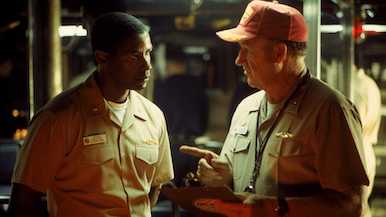|
|
The Number One Movie in America: Crimson TideBy Sean CollierMarch 31, 2020
The subject matter, however, couldn’t have been more different. You’d be forgiven for thinking that “Crimson Tide” is an action movie; outside of a few moments of incoming torpedos and brandished pistols, however, you could recreate it in a black-box theater. This is no fisticuffs-and-chutzpah adventure; rather, it’s a tense drama, pitting its well-drawn characters against one another in a battle of minds and wills. It’s excellent, by the way. Washington and Hackman are in full form, working each other at the edges to see who can raise the other’s blood pressure. Director Tony Scott was never better, simultaneously highlighting the intimidating confinement of the submarine setting and shooting his limited stages in such a way as to maximize visual drama. It’s fundamentally a movie-length argument, yes, but the stakes are so high — and so keenly felt — that “Crimson Tide” is as thrilling as an Indiana Jones escape sequence. (And while this is not a mark of quality, “Crimson Tide” is also a treasure trove of early-career supporting performances. A babyfaced Viggo Mortensen switches sides; a gruff James Gandolfini intimidates; a hapless Steve Zahn ... does all the Steve Zahn things. Look for a blink-and-you’ll-miss it role by Ryan Phillipe, as well; he spends his feature debut staring at a fishtank.) “Crimson Tide” was certainly a success; finishing just shy of the year’s ten top earners is nothing to sneer at. It was nominated for three Oscars. Yet lesser pictures from the same era (and, indeed, from the same director) are more frequently remembered. Like I said: This is an excellent movie. “Crimson Tide” is the subject of the latest episode of The Number One Movie in America, a look back at past box-office champions. Each episode’s film is drawn at random from a list of every number-one movie since 1982. Please listen and subscribe! Next time: Marky Mark gets buff; The Rock gets buffer..
[ View other Number One Movie in America articles ]
[ View other columns by Sean Collier ]
[ Email this column ]
|

|
|
|

|
Friday, November 1, 2024
© 2024 Box Office Prophets, a division of One Of Us, Inc.


